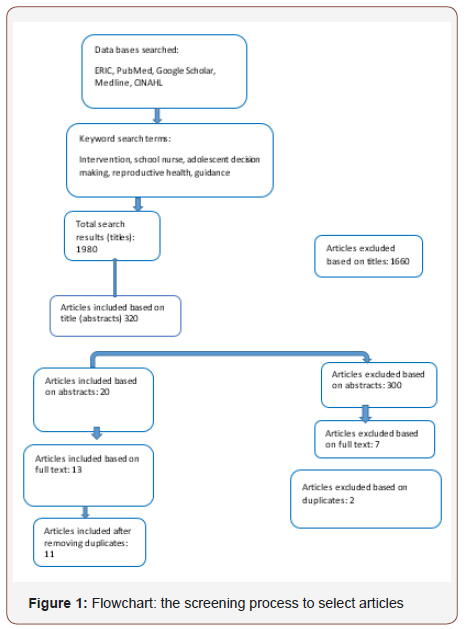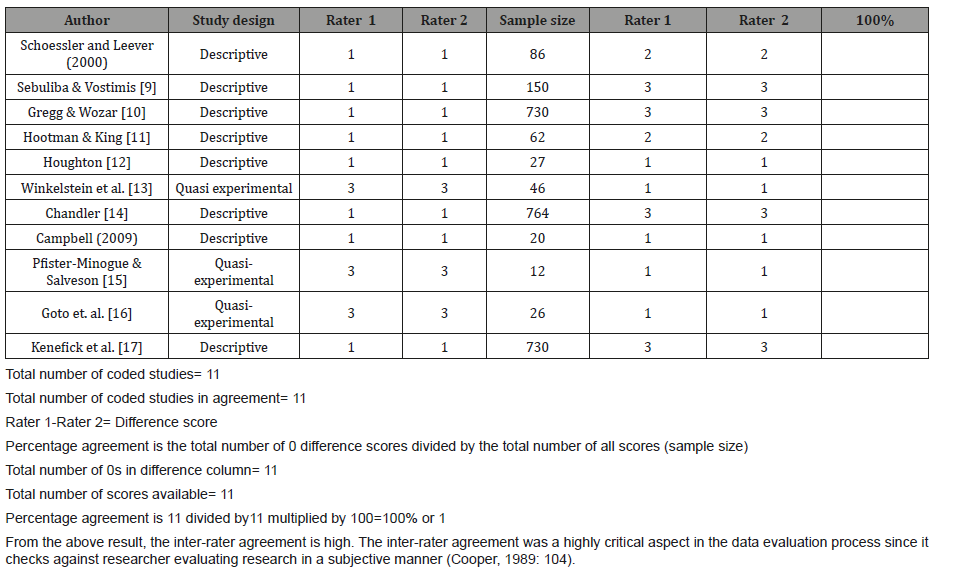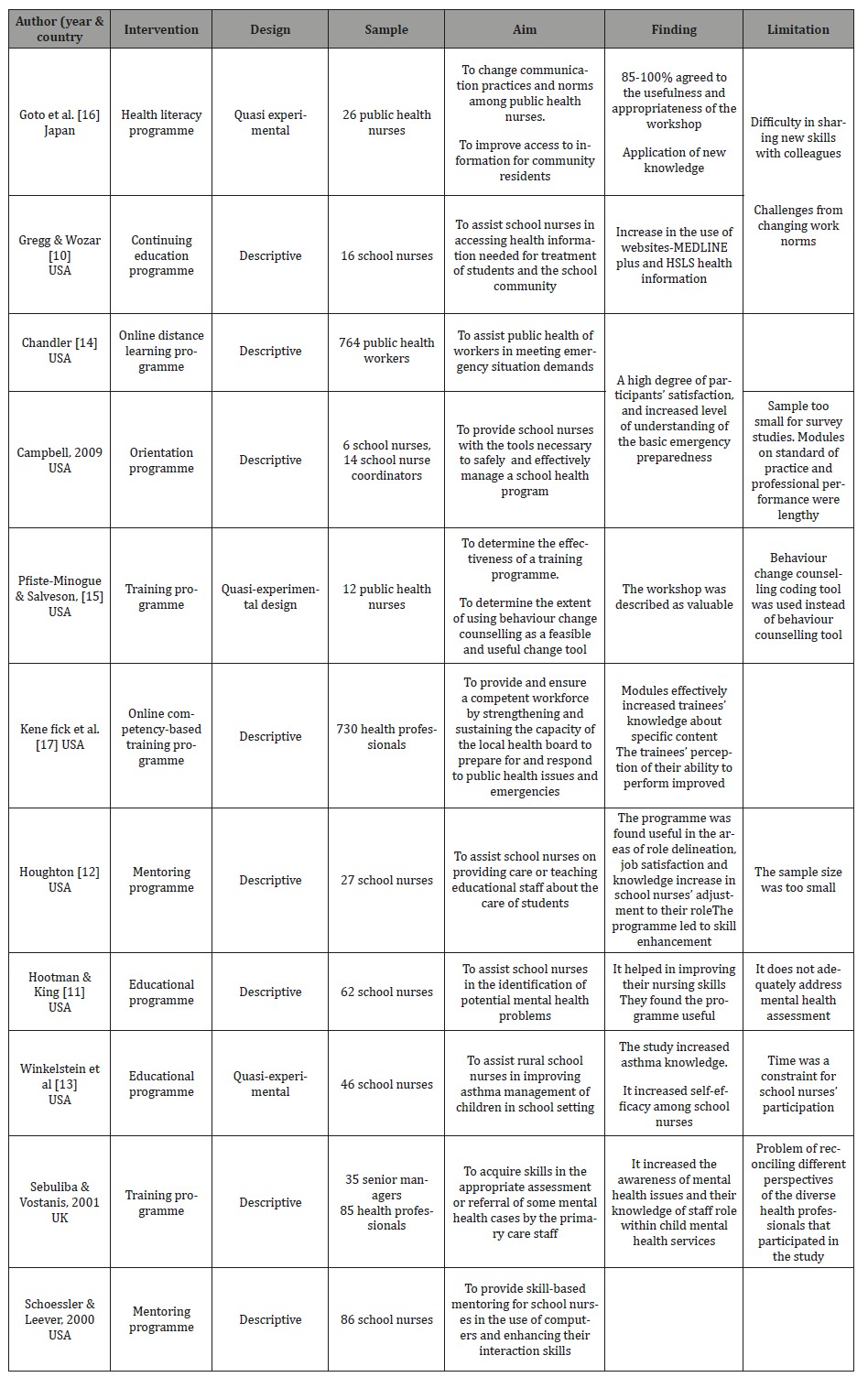 Review Article
Review Article
Integrative Review of Intervention Programmes for School Health Nurses on Their Activities in School Environment (1)
Oluwatoyin A Ogunyewo* and Sathasivan Arunachallam
Faculty of Community and Health Sciences, University of the Western Cape, South Africa
Oluwatoyin A Ogunyewo, School of Nursing, Faculty of Community and Health Sciences, University of the Western Cape, South Africa.
Received Date: March 03, 2019; Published Date: March 19, 2019
Abstract
Aim: This paper reviews descriptive and quasi-experimental studies on the intervention programme developed for school health nurses in order to assist them in different activities which they perform in the school environment. The review was as a result of the need to conduct an integrative review of intervention programmes developed for school health nurses on guiding adolescents about their reproductive health. However, there is a dearth of studies on this particular area, and this prompted the authors to expand the scope to cover the intervention programme developed for school health nurses in other areas of concern.
Methods: Two review questions were raised which prompted the search for articles to provide necessary answers. Computerized database, ancestry and extensive search strategies by titles of research reported in English between 2000 and 2015 located diverse intervention programmes. A total of 1980 articles were retrieved from which 11 were reviewed after series of filtering based on titles, abstracts, full texts, and duplicates had taken place. A broad range of intervention programmes were reported.
Results: The most common intervention programme is training programme which is six in number, followed by education and mentoring programmes which are two each while the number of orientation programme is one. The aims of almost all these programmes was to enhance the knowledge and skills of school health nurses in their areas of practice. Common methodological weakness was small sample.
Conclusion: Integrative review reveals that school health nurses are subject mainly to a training programme in order to enhance their performance in their roles and responsibilities toward adolescents in the secondary school environment.
Introduction
The integrative review helped in analysing the important aspects of those programmes and in discovering the studies conducted in a particular area of research. It helps in interweaving outcomes and results from studies with diverse methodologies aimed at addressing some specific research problems [1]. The integrative review covers a broad range of issues from what is known, the quality of what is known and what must be known. This review was occasioned by the need to conduct an integrative review of intervention programmes for school health nurses on guiding adolescents in their decision making on reproductive health. School is the second most influential environment besides the family environment in the life of an adolescent. School health nurses are expected to perform an adaptive role [2] of guiding adolescents in their decision making about reproductive health in line with the National School Health Policy goals and objectives [3]. However, this is an emerging topic hence the need to conduct a review of intervention programmes that had been developed for school health nurses in other areas of school practice in order to compare notes and distil the common elements in those programmes. Integrative review conducted toward addressing a new or emerging topic enables it to gain from the complete process of development and clarification of concepts and interweaving of literature to date (Torraco, 2005: 357). Integrative review is ingrained in the information gathering and synthesis phase of Thomas and Rothman’s intervention model (2013: 9) which entails uncovering what other researchers or individuals have done to solve similar problems, and it is about “not reinventing the wheel” [4]. The outcome of the activities in this phase constitute a series of functional elements that can be included in the design of an intervention programme. Findings from the analysis of semistructured interviews and focus group discussions that took place in phase one have indicated the need to design and develop a suitable intervention programme for school health nurses toward guiding adolescents in their decision-making about reproductive health, and there was a need to know the functional elements of the successful programmes in areas similar to the issue of focus in this study. In conducting this integrative review, the main review question was developed using the findings from the problem analysis and project planning phase to guide it.
Review Questions
• What types of programs have been developed for school health nurses?
• What were the aims of those programmes?
Cooper (1998) cautions that in formulating a research problem, the operational definitions should neither be too broadly nor too narrowly defined as this might lead to a glossing over of the details resulting in an inappropriate interpretation and consequently jeopardising the quality of research findings. In line with this thinking, the researcher defined intervention programme beyond specific intervention programmes for school health nurses aimed at assisting adolescents in their decision-making about reproductive health. The review covered other programmes designed for school health nurses in other aspects of adolescent health, which were aimed at assisting them in their role performance. The concept of school health nurse was extended beyond its descriptive mark, hence the inclusion of the public health nurse, which is a generic term for any nurse working toward improving the health of members of schools, communities and other places whose health concerns constitute public health.
Literature Search Strategies
This stage encompasses the collection of data from the reports of past important research that include different programmes that were developed for school health nurses. The search included survey studies, descriptive studies, quasi-experimental studies and studies using a mixed-method approach. This is the stage at which the target and accessible population was identified. In this review, the population was school health nurses. Cooper [5] posits that the use of informal, primary and secondary channels and personal research findings are required to effect data collection. The researcher consulted with some experts in school nursing and only a few relevant articles were volunteered. Peer-reviewed journals were searched for relevant articles on the research problem. The ancestry approach, which entails the checking the reference lists of the articles consulted, was undertaken [5]. Literature was mainly sourced from computerised databases. The computerised databases used included: CINAHL (Cumulative Index for Nursing and Allied Health Literature), ERIC (Educational Resources Information Center), PubMed, Google Scholar, and MEDLINE. The assistance of the Faculty librarian was sought in this regard. In developing the search strategy, a set of keywords and descriptors were delineated and truncations were used appropriately so as to guide the search process.
Eligibility Criteria
Articles published between the period 2000 and 2015 were included in the review. This range was purposively selected after a review of literature showed the scantiness of intervention programmes on enhancing school nurses’ role performance. The review included studies conducted only in English. Intervention programmes that have been evaluated were mainly included in the review as these presented the researcher with the programme outcomes. The following eligibility criteria were further considered for the selection of articles: review articles, descriptive studies, triangulated studies, comparative studies, randomised controlled trials, and qualitative studies. The evaluation studies that were inconclusive regarding the outcomes, and study designs were excluded. The initial search yielded 1980 papers. A series of filtering took place based on the inclusion and exclusion criteria. There were three hundred and twenty articles based on title, twenty based on abstracts and thirteen based on full text. The number of remaining articles reviewed is eleven (Figure 1).

Evaluation of Data
This is the stage at which data elements would be assessed for being considered for review. This can be determined before data collection (a priori) or assigning weight to the data elements in all the articles (a posteriori). Implicit in this decision is that less weight is assigned to the weak articles [6]. The eleven remaining articles were evaluated based on the set criteria.
Evaluation criteria for research findings
The researchers employed an adaptation of the evidence scoring system developed by Beck (2001) and later modified by Park & Jones (2010) for evaluating research findings that qualified for a review [7]. Each paper was rated based on its level of evidence using the following criteria:
Study design (experimental) = 3points
Longitudinal= 2 points
Descriptive and qualitative= 1
Sample size (greater than 100=3 points; 50-100= 2 points; and 0-less than 50= 1 point)
The research papers were evaluated and scored by the researcher and a consultant for an inter-rater agreement. The scores are presented in the table below. If the level of closeness is high, it means the difference in their observation is minimal thereby ensuring the consistency of the data collection method. It is normally used for categorical data [8] (Table 1).
Table 1: Inter Rater Agreement Scores of Research Papers.

Data Extraction
A standard format was created which summarized the authors, the design, sample, aims, findings and limitations of the research information. This format helped in comparing the data toward the evolution of the sub-categories, categories and the theme (Table 2).
Table 2: Summary of Characteristics of Included Studies.

Data Analysis
Data analysis entails the reduction of the separate data points obtained by the reviewer into a single unified statement about the problem [5]. The analysis of the data extracted did not require any statistical input. Cooper [6] argues that the integrative review that focuses on identification of intervention programmes would not involve the use of statistics in arriving at a conclusion. The standardized table format allowed the authors to do some comparison of the data as indicated above.
Findings relating to question, “what types of programmes have been developed for school health nurses?”
Altogether, 11 papers qualified for the review. Of these, six papers reported intervention programmes developed exclusively for school nurses, two for public health nurses, one for public health workers, and the remaining two were for all health professionals. Besides those programmes that involved school health nurses exclusively, school nurses were found to be involved in all others. As noted earlier in this study, in some contexts the terms public health nurse and school health nurse are used interchangeably while in others, the public health nurse functions as a school health nurse, and vice versa. None of the studies focused on the provision of guidance to adolescents in decision making about reproductive health by school health nurses. Three of the intervention programmes were health condition-specific, one was about the role socialization of the school health nurses, and two were about mentoring school health nurses, one dealt with emergency preparedness, and one related to the competency of health professionals including school health nurses. One intervention programme each was on field activities and health literacy respectively and the last one focused on computer skills. These programmes reflect the following design forms: training programme (six), education programme (two), orientation programme (one), and mentoring programme (two). For the purposive of this review, each of the intervention programmes will be examined for their nature and relevance.
Findings relating to question 2 “what were the aims of those programmes?
The intervention programmes developed for school health nurses in various health care areas had aims which they focused on addressing. All six training programmes had as their aim enhancing knowledge and skills of school health nurses in their respective roles and responsibilities. The mentoring programme focused on assisting school health nurses toward their role performance. It also targeted enhancing their skills and knowledge for teaching educational staff about the care of their students. The educational programmes addressed issues touching on clinical and interpersonal relationship skills. Lastly, the orientation programme was all about providing school health nurses with the skills necessary to manage a school health programme effectively. These skills are focused on practice and professional performance. The synopsis of all the aims of the respective programmes points in one direction - knowledge and skills enhancement toward building the capacities of school health nurses in their various roles and responsibilities.
Conclusion
Integrative review of intervention programmes developed for school health nurses on some of their different areas of activities in the school environment was used to answer the kinds of programmes that were developed for them, and the aims of those programmes.
Acknowledgement
None.
Conflict of Interest
No conflict of interest.
References
- Crossetti, Maria da Graça Oliveira (2012) Integrative review of nursing research: scientific rigor required. Revista Gaúcha de Enfermagem 33 (2): 12-13.
- Griffin MA, Neal A, Parker SK (2007) A new model of work role performance: Positive behavior in uncertain and interdependent contexts. Academy of Management Journal 50( 2): 327-347.
- Federal Ministry of Education (2006) The national school health policy. Federal Ministry of Education, Abuja, Nigeria.
- Fawcett SB, Suarez Balcazar Y, Balcazar FE, White GW, Paine AL, et al. (2013) Conducting intervention research-the design and development process. Intervention research: Design and development for human service pp. 25-54.
- Cooper HM (1998) Synthesizing research: A guide for literature reviews, Sage.
- Cooper H (1989) Synthesis of research on homework. Educational Leadership 47(3): 85-91.
- Rush KL, Adamack M, Gordon J, Lilly M, Janke R ( 2013) Best practices of formal new graduate nurse transition programs: An integrative review. International Journal of Nursing Studies 50(3): 345-356.
- Gwet KL (2008) Computing inter‐rater reliability and its variance in the presence of high agreement. British Journal of Mathematical and Statistical Psychology 61(1): 29-48.
- Sebuliba D, Vostanis P (2001) Child and adolescent mental health training for primary care staff. Clinical Child Psychology and Psychiatry 6(2): 191-204.
- Gregg AL Wozar JA (2003) Delivering Internet health resources to an underserved health care profession: school nurses. Journal of the Medical Library Association: JMLA 91(4): 398-403.
- Hootman J, Houck GM, King MC (2002) A program to educate school nurses about mental health interventions. The Journal of School Nursing 18(4): 191-195.
- Houghton C (2003) A mentoring program for new school nurses. The Journal of School Nursing 19(1): 24-29.
- Winkelstein ML, Quartey R, Pham L, Lewis-Boyer L, Lewis C, et al. (2006) Asthma education for rural school nurses: Resources, barriers, and outcomes. The Journal of School Nursing 22(3): 170-177.
- Chandler T, Qureshi K, Gebbie KM Morse SS (2008) Teaching emergency preparedness to public health workers: use of blended learning in webbased training. Public Health Reports 123(5): 676-680.
- Pfister Minogue KA, Salveson C (2010) Training and experience of public health nurses in using behavior change counseling. Public Health Nursing 27(6): 544-551.
- Goto A, Rudd RE, Lai AY, Yoshida K (2014) Health literacy training for public health nurses in Fukushima: A case study of program adaptation, implementation and evaluation. JMAJ 57(3): 146-153.
- Kenefick HW, Ravid S, Mac Varish K, Tsoi J, Weill K, et al. (2014) On your time: online training for the public health workforce. Health Promotion Practice 15(1 Suppl): 48S-55S.
- Park M, Jones CB (2010) A retention strategy for newly graduated nurses: an integrative review of orientation programs”, Journal for Nurses in Staff Development 26(4): 142-149.
- Rothman J, Thomas EJ (2013) “An integrative perspective on intervention research”, Intervention research: Design and development for human service. pp. 4-20.
-
Oluwatoyin A Ogunyewo, Sathasivan Arunachallam. Integrative Review of Intervention Programmes for School Health Nurses on Their Activities in School Environment (1). Iris J of Nur & Car. 1(3): 2019. IJNC.MS.ID.000515.
-
Integrative review; Intervention programmes; Reproductive health; Literature search strategies; Scantiness of intervention programmes
-

This work is licensed under a Creative Commons Attribution-NonCommercial 4.0 International License.






